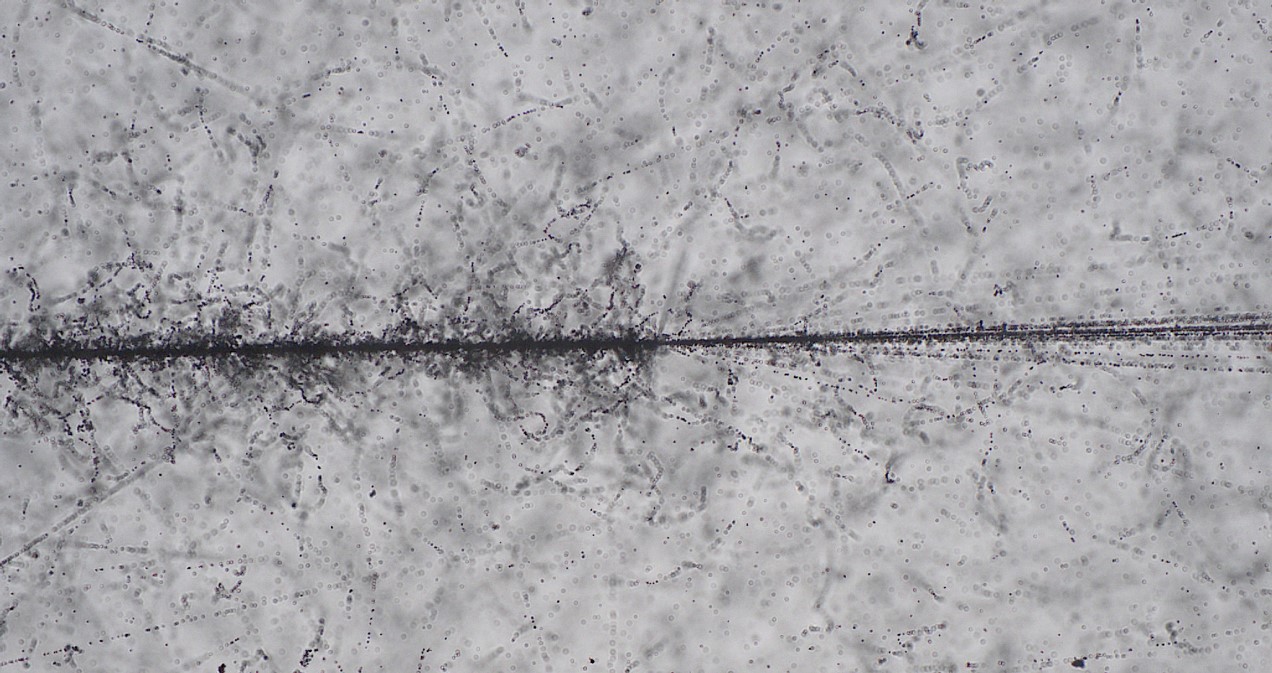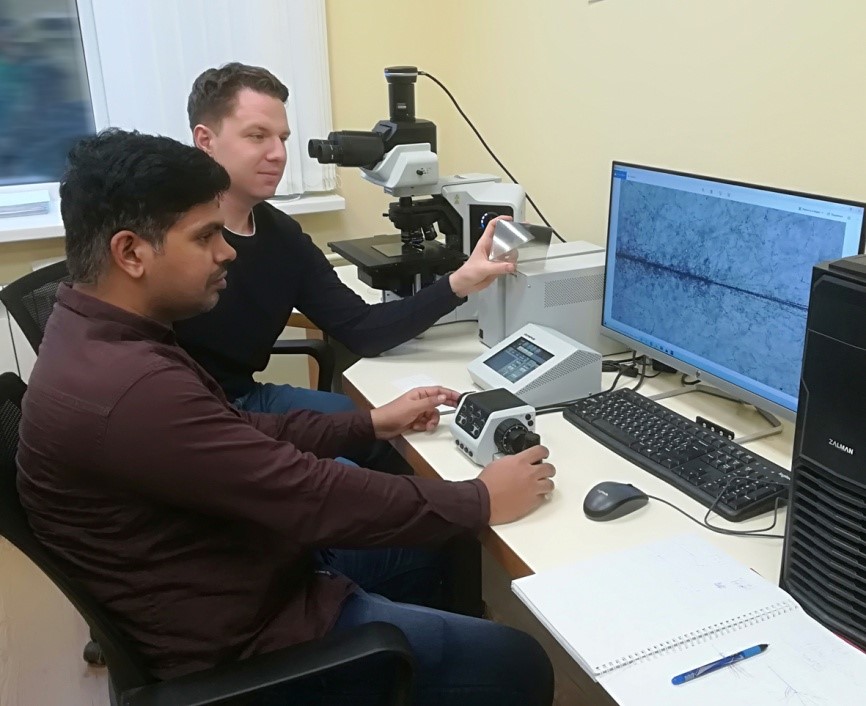“White” stars reconstructed at JINR by nuclear photoemulsion method
News, 30 December 2022
Participants of the BECQUEREL experiment (led by Pavel Zarubin) have started analysing interactions of xenon nuclei with the energy of 3 GeV/nucleon in layers of nuclear emulsion irradiated during the ongoing run at the NICA Accelerator Complex. The obtained macrophotographs of events allow scientists to see the way the interactions of the heaviest particles ever accelerated at NICA look like. It also makes it possible to reconstruct them with high accuracy.
The nuclear photographic emulsion is a suspension of silver bromide microcrystals in 180 µm (about 0.2 mm) thick gelatin layers. Such layers have great sensitivity and allow recording tracks of fragments produced during the decay of nuclei in the “analog” mode. Layers for this experiment were produced at the Micron enterprise of Slavich Company in Pereslavl-Zalessky.
 Photo 1. Macrophotography of peripheral interaction of the Xe nucleus in nuclear emulsion obtained through a 60x lens
Photo 1. Macrophotography of peripheral interaction of the Xe nucleus in nuclear emulsion obtained through a 60x lens
The relativistic fragmentation reveals the structural features of the studied nuclei. The relativistic fragmentation happens at the moment when nuclei with velocity close to the speed of light dissociate at energies sufficient to produce several fragments of nuclei. In this regard, coherent dissociation (simultaneous decay of the same type) events called “white” stars are the most informative ones. Such stars make up several percent of the general statistics of nuclear stars.
Interactions between the projectile nucleus and the emulsion nucleus leave tracks in the emulsion layers. Such events are called nuclear stars. “White” stars are those events during which the target (emulsion) nucleus is not affected, i. e. only the projectile nucleus decays. Such dissociation is possible thanks to the fact that several photons of the target nucleus field attach to the projectile nucleus. Thus, the total energy of the projectile nucleus and photons becomes enough to dissociate the nucleus before it interacts with the target one. Therefore, with “white” stars, only fragments of the projectile nucleus leave tracks in the emulsion. Thus, it is possible to independently study one decayed nucleus. The primary charge of the projectile nucleus in such events is distributed between relativistic fragments. However, there are no tracks of target nucleus fragments and produced mesons. Photo 1 shows a macrophotograph of a “white” star caused by a xenon nucleus. It shows a bright track of the primary nucleus surrounded by tracks of delta electrons and the breakdown of the ionization at the interaction vertex .
The breakdown of the ionization at the interaction vertex describes sudden changes during the dissociation of electrons from atoms of matter. A charged particle that moves through some matter interact with fields of atoms of the matter by its electric field. As a result, electrons of the atoms can dissociate and a neutral atom turns into a charged ion. At the same time, ionization is proportional to the square of the particle charge. Therefore, ionization at different charges is significantly different. For example, xenon has a charge of 54: there are a large number of high-energy electrons around it. When they dissociate, they leave a wide track in the photographic emulsion. When a heavy charged nucleus dissociates during its decay, especially into a large number of fragments, ionization will suddenly decrease, because each of the fragments will have its own ionization. For example, if a nucleus of the heavy particle dissociates into a proton and helium, which ionization is equal to one and four respectively, it is possible to observe a very big difference in the macrophotograph: at the moment of interaction, it is possible to see that a track was wide. Later, it split into many weakly ionizing tracks. The moment when the high ionization turns into low one is called the breakdown of ionization.
Emulsion layers, irradiated with heavy nuclei at the energy of several GeV/nucleon, allow specialists to study nuclear ensembles (many nuclear fragments moving together in one jet) of unprecedented complexity up to isotopes of helium and hydrogen under optimal conditions.
During the decay of the heavy nucleus, many fragments move together at the same time. It is quite difficult to analyse all of them. Electronic detectors cannot cope with this task, because their workload does not allow them to read all this information. However, there is such a possibility when analysing the photoemulsion data.
Thus, it provides opportunity to study rarefied nuclear matter in stars, celestial objects at the temperature range from red giants to supernovas. The study of such processes can find application in solving fundamental and applied problems of modern nuclear physics. Progress in this direction is based on computerized microscopy (photo 2). A significant increase in the energy and intensity of the Xe nuclear beam, compared to the previous irradiation at 1 GeV/nucleon (2010), radically raises the possibilities of studying the phenomenon of multiple fragmentation. Their fulfillment provides research with heavy relativistic nuclei at JINR.
 Photo 2. VBLHEP researchers A. Zaitsev and M. Natarajan (India) are studying the search of interactions of Xe nuclei on the Olympus BX63 microscope
Photo 2. VBLHEP researchers A. Zaitsev and M. Natarajan (India) are studying the search of interactions of Xe nuclei on the Olympus BX63 microscope
A method of thick-layer photoemulsions, in the form in which it is used now, has been known for 50 – 60 years. AgBr crystals with a size of 0.2 microns (2 thousandths of a millimeter) are equally distributed in the gelatin layers. It determines the excellent spatial resolution of the method.
“Electronic tools of recording events do not provide resolution with precision accuracy. Whereas using emulsions, it is possible to trace tracks of all particles, in other words, to completely reconstruct events”, Deputy Head of the Accelerator Department of the Laboratory of High Energy Physics Anatoly Sidorin commented. He said that this method was focused on the discovery of unique events and was not used to collect statistics in modern experiments.
“Modern electronic detectors also allow specialists to observe the process of production of nucleus fragments in the whole dynamics. However, it is impossible to achieve such spatial resolution using them. While using emulsions, the accuracy is microns. The best electronics provides accuracy of hundreds of microns, maybe several tens”, the speaker said. Anatoly Sidorin added that everyday ideas about what happened when two nuclei collided went far enough from reality. Whereas, the method of photoemulsions allows specialists to visually see what happened to the jet of nuclei fragments through a microscope.
Head of the VBLHEP Scientific and Experimental Department of Heavy Ion Physics, Adviser to the VBLHEP Directorate Alexander Malakhov said that specialists had recorded events occurring during the ongoing run at the NICA Accelerator Complex using the method of nuclear photoemulsions. “For the first time, at the Nuclotron, xenon nuclei have been accelerated up to the record energies of about 3 GeV/nucleon and intensity of 2 x 107. The BM@N experimental facility collects statistics but it does not show events, whereas the BECQUEREL experiment allows specialists to see these nuclei and events”, he highlighted.